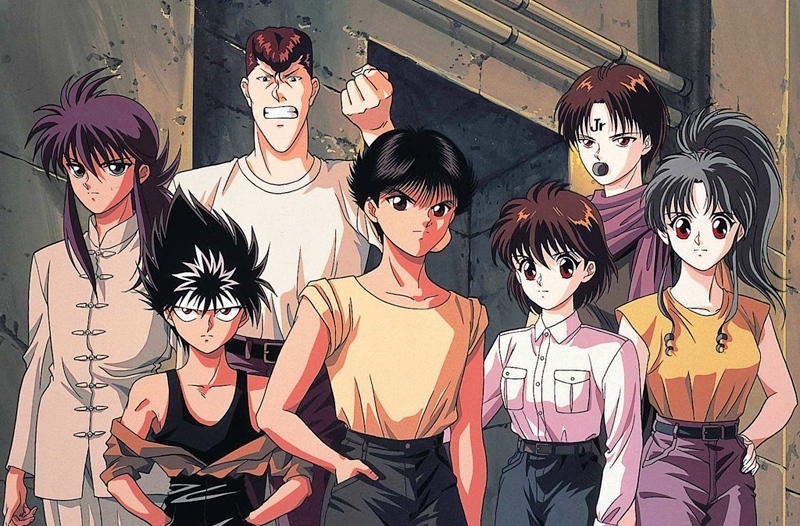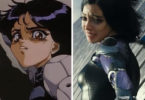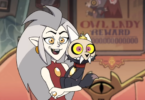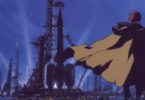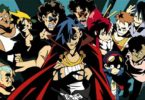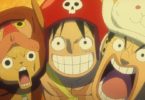To connoisseurs and critics of twentieth-century Japanese culture, it may be tempting, in hindsight, to posit Shōnen anime and manga of the 1990s as having been dominated solely by the likes of Akira Toriyama’s Dragon Ball (1984–1995) and Toei Animation’s televised Dragon Ball Z (1989–1996). (Without question, the franchise was, as it currently remains, a juggernaut.) However, though there were undoubtedly similar (lesser-known) titles being released at the time like Nobuyuki Anzai’s Flame of Recca (1995–2002)—as were, of course, other popular works that fit within neither the Shōnen demographic nor genres related to fighting or the martial arts—there is one manga-turned-anime in particular, cut from a similar cloth, that once stood toe-to-toe with Toriyama’s iconic creation.
Yoshihiro Togashi’s Yu Yu Hakusho (1990–1994) features a punk protagonist who, despite a shared penchant for returning from the dead and being generally hard-headed, is rather unlike the hero of Dragon Ball. Unlike the carefree, fairly innocent Son Goku, Togashi’s main character is a bit of a delinquent who regularly rebels against authority. Capitalizing on the popularity of young ‘detective’ Yusuke Urameshi—a school-skipping teenage brawler with a heart (and egg) of gold—Studio Pierrot’s adaptation Yu Yu Hakusho (1992–1994) was also well-received, and like Dragon Ball Z was also given new life when localized versions aired on television in America and numerous other countries several years later. The series also proved to be solid ground upon which director Noriyuki Abe could cement his reputation as a master metteur en scène, as many of the other works for which he is known—chiefly other Pierrot adaptations like the previously mentioned Flame of Recca (1997–1998), Bleach (2004–2012), and Black Butler: Book of Circus (2014)—are competent animated transpositions of preexisting (and almost always popular) serialized source material.
Yu Yu Hakusho owes some of its uniqueness to creative cherry-picking, on the part of Togashi himself, from a wide array of other source material to compliment its own stylistic elements; yet, curiously, this in no way weakens its own artistic fidelity. For example, Younger Toguro resembles Arnold Schwarzenegger’s Terminator in overall appearance, indestructibility, and even in certain situational scenarios (e.g. riding a motorcycle when recruiting Yusuke for the Dark Tournament, or eerily emerging from the fiery rubble of Yusuke’s attack unharmed). It has also been reported that the character’s voice actor, Tessho Genda, also assumed Schwarzenegger’s Terminator role in Japanese dubs of the Terminator films, suggesting some serious typecasting (though whether this was done purposefully in relation to Yu Yu Hakusho or by mere coincidence is another matter). Yet Toguro is no mere parody or knockoff of the Terminator, nor can Togashi’s habit of selective inspiration be considered proper pastiche: Younger Toguro is a unique character, one which will no doubt be an inspiration all his own in years to come.
This isn’t to say that Togashi never treads the waters of loose parody in a spirit of good fun. As many fans initially suspected, Togashi has apparently been quoted as confirming after the fact that the beginning of the Chapter Black arc—Genkai’s lesson for Yusuke and company in the form of battling psychics with ‘territories’ that afford them special abilities within a mansion which would make M. C. Escher dizzy—was very much meant to resemble fellow manga artist Hirohiko Araki’s Jojo’s Bizarre Adventure (1987–), as Part 4 (Diamond Is Unbreakable) was being serialized around the same time as Togashi’s previously mentioned installment. And it also isn’t to say that Togashi, specifically via Yu Yu Hakusho, hasn’t already been hugely influential: Masashi Kishimoto, author of Naruto (1999–2014), has indicated that character Sasuke Uchiha is based in part on Hiei, and the Nine Tails beast Kurama (though partially based on the longstanding kitsune creatures of Japanese lore) is also explicitly based on Togashi’s fox spirit Yoko Kurama. As for other possible allusions on the part of either Togashi or Abe—the similarities of Elder Toguro to Hitoshi Iwaaki’s Parasyte (1988–1995), particularly in the flashback scene where the demon possesses a psychic called Gourmet, or my own nagging (yet completely unfounded) suspicion that there are strange parallels between Shinobu Sensui’s and Colonel Kurtz’ (of Francis Ford Coppola’s 1979 war film Apocalypse Now) respective descents into madness, conflicting nihilistic attitudes towards humanity, and odd admiration for those whom they were indoctrinated to treat as the enemy—one can only speculate.
But while Toriyama’s iconic work has been given a drastic revival thanks to Dragon Ball Super (2015–), Yu Yu Hakusho becomes more of a historical artifact with each passing day. However, Togashi’s name has stayed in the limelight of current anime and manga fandom due to the success of his other work Hunter x Hunter (1998–), which itself has seen not one but two different animated adaptations by Nippon Animation (1999–2001) and Madhouse, Inc. (2011–). Many younger fans of Hunter x Hunter are unfamiliar with Togashi’s earlier work, often unaware of Yu Yu Hakusho’s existence. While this fact may induce geriatric dread for those who grew up with the scrappy high-school wielder of the Spirit Gun, it should also be gratifying to know that neither Hunter x Hunter nor its patrons risk being caught in the formidable undertow of its older sibling’s well-earned reputation; and, similarly, it ought to be appreciated that Togashi as an artist has been fortunate enough to have not one but two distinct smash hits for which he is admired. And for fans of both, it is surely entertaining to spy some similarities between Togashi’s characters from both works, like Ging Freecss’ superficial resemblance to Yusuke Urameshi.
Despite its age and period-specific aesthetic (whether referring to its beautiful cel animation or totally rad late-eighties fashion sensibilities), like any great work the important components of Yu Yu Hakusho remain timeless. Characters like the wise Genkai and dedicated pep talker Botan are unforgettable, as are many of the important lessons they teach. Yusuke’s journey of maturation showcases countless profound themes as he grows from apathetic ne’er-do-well to champion of humanity, a troubled youth fighting for nothing into a responsible, caring adult. There will always be dissidents in the world, in every country and in every era, who may potentially identify with an unlikely hero like Yusuke. And rather than blindly submitting to authority or becoming the next supervillain, another path, one which might resemble Urameshi’s, between these extremes always exists: become the best version of yourself that you can be, while realizing that there’s always someone better out there and always room for improvement. Strive to do the right thing (as best as you can peg it), not simply because somebody—a teacher, parent, government leader, or religious figure—tells you so, but because the people who care about you (and much of the rest of the world, be it this one, Spirit World, or even Demon World) rely on it more than it may seem. And, as opposed to dominating or subjugating others, real strength comes from having power and being able to exercise restraint.
As long as there are lovably immature, slightly troubled adolescents looking for validation from role models (and, of course, a chance to shake things up) while seeking to prove themselves to the world, Yu Yu Hakusho will always have a reserved seat at the table of popular culture. At least in America, as is perhaps the case elsewhere, the belief that one’s checkered past need not prevent eventual personal success or moral redemption—only if one resolutely chooses to turn over a new proverbial leaf, of course—is just too appealing to fade away any time soon.
© 2018

